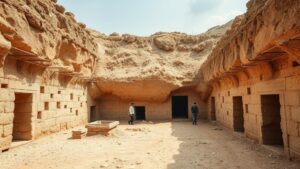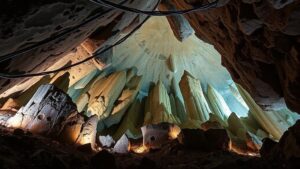Investigating the “River of Stars,” a glowing underground stream tied to ancient myths.
Investigating the “River of Stars”: A Glowing Underground Stream Tied to Ancient Myths
In various parts of the world, myths and folklore often interweave with nature, giving birth to captivating narratives. One such enchanting phenomenon is the “River of Stars,” a luminescent underground stream believed to exist beneath certain regions, steeped in legends and scientific curiosity alike. This article delves into the cultural significance, scientific investigations, and real-world occurrences of this mythical place.
The Mythical Origins of the “River of Stars”
The concept of the “River of Stars” is not a singular narrative but rather a tapestry of stories that emerge from diverse cultures. In many Indigenous cultures of North America, this glowing stream is likened to divine pathways leading the souls of ancestors to the afterlife. Similarly, in Chinese mythology, the Milky Way is often depicted as a river where stars flow, symbolizing a connection between heaven and earth. These myths reflect humanity’s enduring fascination with the cosmos and our origins.
Scientific Investigations and Discoveries
While the mythic tales are compelling, the scientific community has taken a serious interest in the existence of luminescent streams. phenomenon of bioluminescence is key to understanding these glowing waterways. Organisms such as certain species of microorganisms, fungi, and insects are capable of producing light through biochemical reactions. For example, the bioluminescent algae found in saltwater bodies, like the famous Mosquito Bay in Vieques, Puerto Rico, create stunning light displays similar to what one might imagine of the River of Stars.
Research shows that bioluminescence is primarily driven by luciferin, a light-emitting compound, and the enzyme luciferase. This interaction can create visually captivating displays, especially in dark environments. In underground streams, specific conditions like the presence of certain bacteria or algae can lead to a vibrant glowing effect, capturing the imagination of anyone fortunate enough to witness it.
Notable Locations and Real-World Applications
Several locations around the globe are known for their bioluminescent characteristics, often drawing visitors eager to experience this natural wonder:
- Blue Grotto, Italy: This cavernous sea grotto emits an ethereal blue glow due to submerged rocks reflecting sunlight in a specific manner.
- Bioluminescent Bay, Vieques: Recognized as one of the brightest bioluminescent bays globally, it is home to dense populations of dinoflagellates that illuminate the waters surface at night.
- Waitomo Caves, New Zealand: Famous for its glowworm population, these caves provide a breathtaking view of luminous organisms illuminating the underground passages.
These locations exemplify real-world applications of the phenomena often associated with the River of Stars, as they offer not just aesthetic pleasure but also insights into ecological systems and bioluminescences potential uses in science and technology. For example, harnessing bioluminescent organisms can lead to advancements in sustainable lighting solutions.
Potential Questions and Concerns
As with all natural phenomena, the investigation of the River of Stars raises questions regarding environmental impacts and sustainability. mass tourism surrounding bioluminescent sites, for example, threatens delicate ecosystems. Concerns regarding the over-harvesting of certain bioluminescent organisms, particularly in sensitive areas, are prevalent. Scientists emphasize the importance of responsible tourism and research to protect these natural wonders while fostering appreciation for them.
Conclusion: Bridging Myth and Reality
The allure of the “River of Stars” lies at the intersection of myth and scientific reality. While ancient stories remind us of the rich narrative tapestry that defines human interaction with nature, scientific inquiry uncovers the underlying mechanisms that breathe life into these tales. In our exploration of these glowing underground streams, we not only honor the wisdom of our ancestors but also pave the way for future generations to appreciate and protect the natural world.
As you seek to explore these captivating phenomena, consider local conservation efforts to support sustainable practices that preserve the beauty of the River of Stars and other bioluminescent environments. The journey to understanding the relationship between mythology and nature continues to be an essential part of our collective human story.



